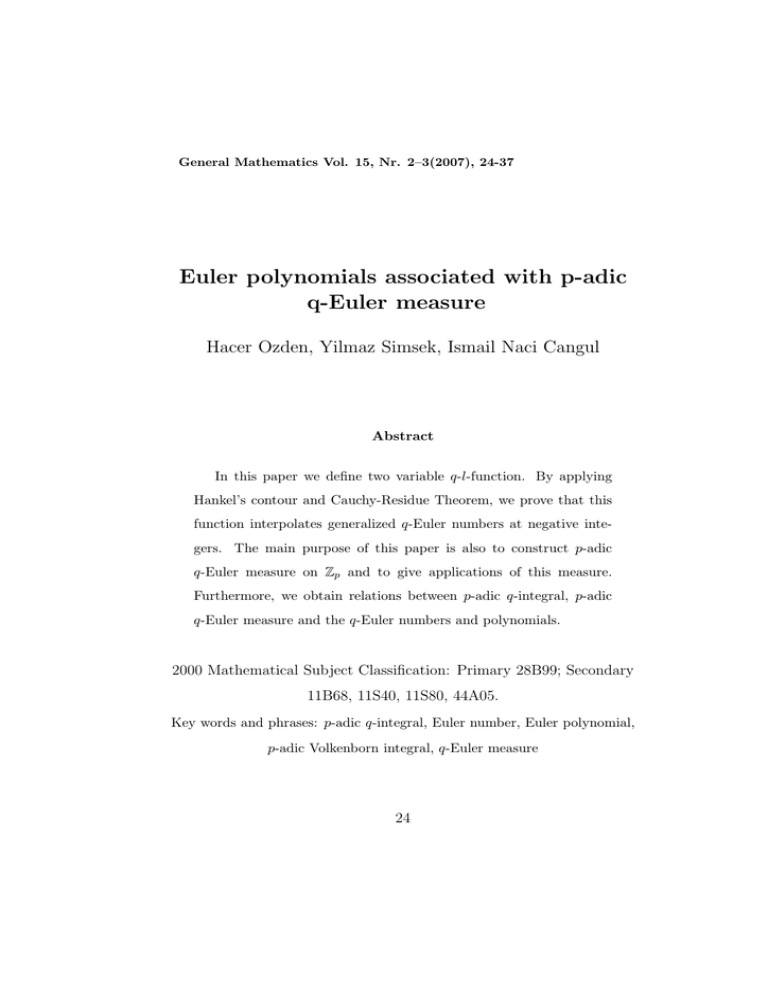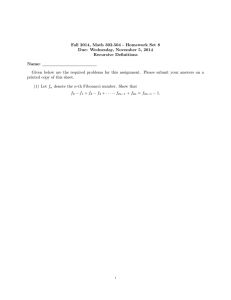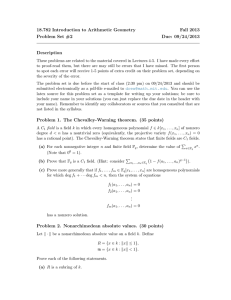Euler polynomials associated with p-adic q-Euler measure
advertisement

General Mathematics Vol. 15, Nr. 2–3(2007), 24-37 Euler polynomials associated with p-adic q-Euler measure Hacer Ozden, Yilmaz Simsek, Ismail Naci Cangul Abstract In this paper we define two variable q-l-function. By applying Hankel’s contour and Cauchy-Residue Theorem, we prove that this function interpolates generalized q-Euler numbers at negative integers. The main purpose of this paper is also to construct p-adic q-Euler measure on Zp and to give applications of this measure. Furthermore, we obtain relations between p-adic q-integral, p-adic q-Euler measure and the q-Euler numbers and polynomials. 2000 Mathematical Subject Classification: Primary 28B99; Secondary 11B68, 11S40, 11S80, 44A05. Key words and phrases: p-adic q-integral, Euler number, Euler polynomial, p-adic Volkenborn integral, q-Euler measure 24 Euler polynomials associated with p-adic q-Euler measure 1 25 Introduction, definitions and notations In this section, we give some notations and definitions, which are used in this paper. Let p be a fixed odd prime. Throughout this paper Zp , Qp , C and Cp will respectively denote the ring of p-adic rational integers, the field of padic rational numbers, the complex number field and the completion of the algebraic closure of Qp . Let vp be the normalized exponential valuation of Cp with |p|p = p−vp (p) = 1/p, cf. ([3], [4], [5]). When we talk of q-extension, q is variously considered as an indeterminate, either a complex q ∈ C, or a p-adic number q ∈ Cp . If q ∈ C, we normally assume |q| < 1. If q ∈ Cp , 1 then we assume |q − 1|p < p− p−1 , so that q x = exp(x log q) for |x|p ≤ 1, cf. ([6], [7], [21]). For a fixed positive integer d with (p, d) = 1, set Xd = lim Z/dpN Z, X1 = Zp , ← N X∗ = ∪ (a + dpZp ), 0<a<dp (a,p)=1 a + dpN Zp = x ∈ X : x ≡ a(moddpN ) , where a ∈ Z satisfies the condition 0 ≤ a < dpN , cf. ([21], [15]). For a uniformly differentiable function f at a point a ∈ Zp we write f ∈ U D(Zp ), if the difference quotient Ff (x, y) = f (x) − f (y) , x−y 26 Hacer Ozden, Yilmaz Simsek, Ismail Naci Cangul has a limit f´(a) as (x, y) → (a, a). For f ∈ U D(Zp ), an invariant p-adic q-integral was defined by Iq (f ) = Zp f (x)dμq (x) = lim N →∞ ⎧ ⎨ where [x]q = ⎩ , q = 1 x ,q = 1 [x]−q = [pN ]q 1−q x 1−q and pN −1 1 f (x)q x , x=0 , 1 − (−q)x , 1+q The modified p-adic q-integral on Zp is defined by (1) I−q (f ) = f (x)dμ−q (x), Zp where dμ−q (x) = lim dμq (x) cf. ([10], [2], [7], [8], [3], [4], [9], [11], [6], [21], q→−q [16]). The classical Euler numbers are defined by the following generating function tn 2 = En , |t| < π, et + 1 n=0 n! ∞ From the above function, we have E0 = 1, E1 = −1 1 , E2 = 0, E3 = , · · · . 2 4 These numbers are interpolated by the following function at the negative integers: (2) ζE (s) = ∞ (−1)n n=1 ns , s ∈ C. Euler polynomials associated with p-adic q-Euler measure 27 This function interpolates Euler numbers at negative integers. For s = −n, n ∈ Z+ , we have ζE (−n) = En , cf. (see for detail [12], [22], [21], [3], [4], [5], [6], [7], [21], [1], [10], [2], [8], [11], [14], [13], [17], [18], [19], [20]). The main motivation of this paper are summarized as follows: In Section 2, we define two variable q-l-functions. By using Hankel’s contour and Cauchy-Residue Theorem, we find explicit values of the two variable q-l-functions at negative integers. In Section 3, we construct p-adic q-Euler measure on Zp . By using this measure, we prove relations between p-adic q-integral, p-adic q-Euler measure and the q-Euler numbers and polynomials. We also give some applications as well. 2 Interpolation functions of the q-Euler numbers and polynomials on C In this chapter, we assume that q ∈ C, with |q| < 1. q-extension of Euler polynomials, En,q (x) are defined by 2etx tn Fq (t, x) = t En,q (x) cf. [14]. = qe + 1 n=0 n! ∞ (3) By using (3), and Taylor series of etx , we have ∞ tn n tn (h) tn = En,q x E (x) . n! n=0 n! n=0 n,q n! n=0 ∞ ∞ By Cauchy product in the above, we have the following theorem: 28 Hacer Ozden, Yilmaz Simsek, Ismail Naci Cangul Theorem 1. ([14]) Let n ∈ N. Then we have ⎛ ⎞ n n (h) ⎝ ⎠ xn−k Ek,q (4) En,q (x) = (x). k k=0 Theorem 2. ([14])(Distribution Relation) For d is an odd positive integer, k ∈ N, we have k (5) Ek,q (x, q) = d d−1 a a (−1) q Ek,qd a=0 x+a d . By applying Mellin transform to (3), we define Hurwitz type zeta function as follows: (6) 1 ζq (s, x) = Γ(s) ∞ 0 ts−1 Fq (−t, x)dt, (for detail see also [14]). This function interpolates En,q (x) polynomial at negative integers. By using the complex integral representation of generating function of the polynomials En,q (x), we have ∞ 1 (−1)n En,q (x) 1 s−1 t Fq (−t, x)dt = tn+s−1 dt, Γ(s) C n! Γ(s) C n=0 where C is Hankel’s contour along the cut joining the points z = 0 and z = ∞ on the real axis, which starts from the point at ∞, encircles the origin (z = 0) once in the positive (counter-clockwise) direction, and returns to the point at ∞, (see for detail [23], [11], [19], [21]). By using (6) and Cauchy-Residue Theorem, we arrive at the following theorem: Theorem 3. Let k ∈ N. Then we have (7) ζq (−k, x) = Ek,q (x). Euler polynomials associated with p-adic q-Euler measure 29 Generalized q-Euler polynomials are defined by means of the following generating function [14]: (8) Fq (t, x, χ) = 2 d−1 a t(a+x) a q a=0 (−1) χ(a)e td qe + 1 = ∞ En,χ,q (x) n=0 tn π , |t + log q| < . n! d Remark 1. From the above generating function we assume that d is an odd integer, we have Fq (t, x, χ) = (9) 2 = 2 d−1 a t(a+x) a q a=0 (−1) χ(a)e qetd + 1 d−1 (−1)a χ(a)et(a+x) q a a=0 = 2 ∞ ∞ (−1)n q n etdn n=0 (−1)m χ(m)q m e(m+x)t m=0 By applying Mellin transform to (9), we define two variable q-l-function as follows: (10) ∞ 1 ts−1 Fq (−t, x, χ)dt lq (s, χ; x) = Γ(s) 0 ∞ (−1)n χ(n)q n . = 2 s (n + x) n=0 Definition 1. Let s ∈ C. We define lq (s, χ; x) = 2 ∞ (−1)n χ(n)q n n=0 (n + x)s . Observe that if x = 1, then lq (s, χ; x) reduces to lq (s, χ; x) = 2 ∞ (−1)n χ(n)q n n=1 ns . 30 Hacer Ozden, Yilmaz Simsek, Ismail Naci Cangul This function interpolates q-generalized Euler numbers at negative integers. And lim lq (s, χ) = l(s, χ) = 2 q→1 ∞ (−1)n χ(n) n=1 ns , this function interpolates generalized Euler numbers at negative integers. Substituting χ ≡ 1 into the above, then the function l(s, 1) reduces to (2). By using the complex integral representation of generating function in (9), we have ∞ (−1)n En,χ,q (x) 1 1 s−1 t Fq (−t, x, χ)dt = tn+s−1 dt, Γ(s) C n! Γ(s) C n=0 where C is Hankel’s contour along the cut joining the points z = 0 and z = ∞ on the real axis, which starts from the point at ∞, encircles the origin (z = 0) once in the positive (counter-clockwise) direction, and returns to the point at ∞. By using (10) and Cauchy-Residue Theorem, we arrive at the following theorem: Theorem 4. Let k ∈ N. Then we have lq (−k, χ; x) = En,χ,q (x). Remark 2. Proofs of Theorem 2 and Theorem 3 were given by Ozden and Simsek. Their proofs are related to derivative operator on generating functions of the q-Euler polynomials and generalized q-Euler polynomials. 3 p-adic q-Euler measure on X 1 In this section, we assume that q ∈ Cp with |q − 1|p < p− p−1 , so that q x = exp(x log q) for |x|p ≤ 1. Let χ be a primitive Dirichlet character with Euler polynomials associated with p-adic q-Euler measure 31 a conductor d(= odd) ∈ N. By using (5), we define a distribution on X. By using this distribution, we construct a measure on X. We give relations between p-adic q-Euler measure, p-adic q-integral and q-Euler numbers and polynomials. Let N , k and d (= odd) be positive integers. We define μ∗k = μ∗k,q;E as follows: μ∗k (a (11) a + dp Zp ) = (−1) (dp ) N N k−1 a q Ek a N , q dp N dp . Now we show that μ∗k (a + dpN Zp ) is a distribution on X as follows: By using (5) and (11), we obtain p−1 μ∗k (a + jdpN + dpN +1 Zp ) j=0 = = = = = a + jdpN dpN +1 (−1) (dp ) q Ek ,q N +1 dp j=0 a p−1 + j dpN p N dpN a a jdpN jdp N +1 k−1 (−1) q (dp ) (−1) q Ek , (q ) p j=0 a p−1 + j dpN p dpN j dpN a a j N k−1 k−1 , (q ) (−1) q (dp ) p (−1) (q ) Ek p j=0 a a a N k−1 k−1 dpN ,q (−1) q (dp ) p Ek dpN μ∗k (a + dpN Zp ). p−1 a+jdpN N +1 k−1 a+jdpN Therefore we easily arrive at the following theorem Theorem 5. Let N , k and d (= odd) be positive integers, then a a ∗ N N k−1 a dpN ,q μk (a + dp Zp ) = (−1) (dp ) q Ek dpN is a distribution on X. 32 Hacer Ozden, Yilmaz Simsek, Ismail Naci Cangul Substituting f (x) = q x etx into (1), we obtain (3) cf. [14]. By using (3), we have 2etx = (−1)n q n et(n+x) . t qe + 1 n=0 ∞ (12) From the above series and Theorem 5, we arrive at the following theorem: Theorem 6. If q ∈ Zp with |1 − q|p ≤ 1, then μ∗k is a measure on X. Proof. From Theorem 5, (5) and (12) we easily arrive at the desired result. Theorem 7. For any positive integer k, we have dμ∗k (x) = Ek (q). Zp Proof. By Theorem 6 we have Zp dpN −1 ∗ dμk (x) = lim N →∞ = lim μ∗k (x + dpN Zp ) x=0 N −1 d−1 p N →∞ μ∗k (a + jd + dpN Zp ). a=0 j=0 By using Theorem 5, we get −1 d−1 p a + jd dpN = lim (−1)a+jd (dpN )k−1 q a+jd Ek ( ,q ) N N →∞ dp a=0 j=0 N = d−1 pN −1 (−1) q d a=0 = a a k−1 N k−1 lim (p ) N →∞ d−1 a (−1)a q a dk−1 Ek ( , q d ) d a=0 = Ek (q). Thus we complete the proof. j=0 a (−1)j (q j )d Ek ( d + j d pN , (q ) ) pN Euler polynomials associated with p-adic q-Euler measure 33 Theorem 8. Let χ be the Dirichlet’s character with an odd conductor d ∈ N. Then we have X χ(x)dμ∗k (x) = Ek,χ (q). Proof. X dpN −1 ∗ χ(x)dμk (x) = = = lim N →∞ lim χ(a + jd)μ∗k (a + jd + dpN Zp ) a=0 j=0 d−1 N →∞ = dk−1 x=0 N −1 d−1 p N →∞ lim χ(x)μ∗k (x + dpN Zp ) pN −1 χ(a) a=0 d−1 (−1)a+jd q a+jd (dpN )k−1 Ek ( j=0 a + jd dpN ,q ) dpN (−1)a q a χ(a) a=0 pN −1 × lim (p ) N k−1 N →∞ = dk−1 a (−1)j (q d )j Ek ( d j=0 + j d pN , (q ) ) pN d−1 a (−1)a q a χ(a)Ek ( , q d ) d a=0 = Ek, χ(q) Remark 3. By using μ∗k on X∗ , and X∗ f (x)χ(x)dμ∗k (x), we may have many applications related to p-adic l-function and q-generalized Euler numbers. Acknowledgement 1 The first and fourth authors are supported by the Scientific Research Fund of Uludag University, Project no: F-2006/40. The second author is supported by the Research Fund of Akdeniz University 34 Hacer Ozden, Yilmaz Simsek, Ismail Naci Cangul References [1] L-C. Jang, On a q-analogue of the p-adic generalized twisted Lfunctions and p-adic q-integrals, J. Korean Math. Soc. 44(1) (2007), 1-10. [2] T. Kim, q-Volkenborn integation, Russ. J. Math. Phys. 9 (2002), 288299. [3] T. Kim, The modified q-Euler numbers and polynomials, ArXive:math.NT/0702523. [4] T. Kim, On a q-analogue of the p-adic log gamma functions, J. Number Theory 16 (1999), 320-329. [5] T. Kim, On the q-extension of Euler and Genocchi numbers, J. Math. Anal. Appl. 326 (2007), 1458-1465. [6] T. Kim, Sums of powers of consecutive q-integers, Advan. Stud. Contemp. Math. 9 (2004), 15-18. [7] T. Kim, An invariant p-adic q-integral on Zp , Appl. Math. Letters, In Press, Corrected Proof, Available online 20 February 2007. [8] T. Kim, On the analogs of Euler numbers and polynomials associated with p-adic q-integral on Zp at q = −1, J. Math. Anal. Appl. 331 (2007), 779-792. [9] T. Kim, q-Euler numbers and polynomials associated with p-adic qintegrals, J. Nonlinear Math. Phys. 14(1) (2007), 15-27. Euler polynomials associated with p-adic q-Euler measure 35 [10] T. Kim, A new approach to q-zeta function, J. Comput. Analy. Appl. 9 (2007), 395-400. [11] T. Kim and S.-H. Rim, A new Changhee q-Euler numbers and polynomials associated with p-adic q-integral, Computers & Math. Appl. 54(4) (2007), 484-489. [12] Q.-M. Luo and H. M. Srivastava, Some relationships between the Apostol-Bernoulli and Apostol-Euler polynomials, Comput. Math. Appl. 10 (2005), 631-642. [13] H. Ozden, Y. Simsek, S-H. Rim and I. N. Cangul, A note on p-adic q-Euler measure, Advan. Stud. Contemp. Math., 14(2) (2007), 233-239. [14] H. Ozden and Y. Simsek, A new extension of q-Euler numbers and polynomials related to their interpolation functions, preprint. [15] S-H. Rim, Y. Simsek, V. Kurt and T. Kim, On p-adic twisted Euler (h, q)-l -function, ArXive:math.NT /0702310. [16] S-H. Rim, T. Kim, A note on q-Euler numbers associated with the basic q-zeta function, Appl. Math. Letters 20(4) (2007), 366-369. [17] Y. Simsek, On twisted generalized Euler numbers, Bull. Korean Math. Soc. 41(2) (2004), 299-306. [18] Y. Simsek, q-analogue of twisted l-series and q-twisted Euler numbers, J. Number Theory 110(2) (2005), 267–278. 36 Hacer Ozden, Yilmaz Simsek, Ismail Naci Cangul [19] Y. Simsek, Twisted (h, q)-Bernoulli numbers and polynomials related to twisted (h, q)-zeta function and L-function, J. Math. Anal. Appl. 324 (2006), 790-804. [20] Y. Simsek, q-Hardy-Berndt type sums associated with q-Genocchi type zeta and l-functions, submitted. [21] H. M. Srivastava, T. Kim, Y. Simsek, q-Bernoulli numbers and polynomials associated with multiple q-zeta functions and basic L-series, Russian J. Math. Phys. 12 (2005), 241-268. [22] H. M. Srivastava and J. Choi, Series Associated with the Zeta and Related Functions, Kluwer Acedemic Publishers, Dordrecht, Boston and London, 2001. [23] E. T. Wittaker and G. N. Watson, A Course of Modern Analysis, 4th. Edition, Cambridge University Press, Cambridge, 1962. Hacer Ozden and Ismail Naci Cangul Department of Mathematics Faculty of Arts Science University of Uludag 16059 Bursa, Turkey Email addresses: hozden@uludag.edu.tr , cangul@uludag.edu.tr Euler polynomials associated with p-adic q-Euler measure Yilmaz Simsek Department of Mathematics Faculty of Science University of Akdeniz 07058 Antalya, Turkey Email addresses: yilmazsimsek@hotmail.com 37



